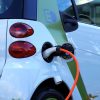5 Best Practices for Charging Your Electric Car at Home
An electric car provides many benefits to motorists. They are fuel efficient, they save money on fuel costs and they emit extremely low emission levels. Another great benefit of electrical vehicles is charging them at home. Here are 5 best practices for charging your electric vehicle in your house. These hacks will help you to charge your car more efficiently and effectively.
1. Don’t Fully Charge your Battery
According to Plug-In Cars, electric vehicle owners should only charge their batteries to 80%. They claim that charging your battery to 80% will help to extend the life of this power source. Most people charge their batteries to 100%. However, when a battery is fully charge it doesn’t last as long because people are constantly draining the energy from the unit. Eventually, the battery will lose its chemical energy and go dead at a faster rate. However, if you charge it only to 80% then you will lose less chemical energy and preserve the battery for a longer time.
2. Maintain Idea Charging Conditions for your Battery
Inside EVS states that batteries should be charged and maintained within compatible environments. Heat is an enemy of any battery source. Hot conditions will cause a battery to work harder to charge and it will drain it faster. If you’re charging your battery outside in hot temperatures (90 Fahrenheit/32.2 Celsius or over) then you should cover your unit. By the way, you should also park in a place where there is shade on a hot day. This too will help to keep your battery from draining too fast.
Also charge your battery at home in a cool enough place that will allow your battery to adequately charge. Remember cool temperatures help batteries to hold their charge longer. Hot and cold heat extremes will make it harder to charge your unit. Try to charge your batteries in a room temperature (62 Fahrenheit/16.6 Celsius) environment for best results.
3. Charge your EV Battery at Night
Charging your EV battery at night will help you to save money on your energy bill. Night-time charging might also be better suited for people who live in hot or warm climates. You should also charge your battery after peak time hours. Peak time electric use is between 3 p.m. to 9 p.m. This is the time frame that most people come home and start do things around the house. Another major peak time is between 6 a.m. to 9 a.m. This is the time frame that most people wake up and begin their day. The most effective time to charge your EV battery is between 10 p.m. to 5 a.m. You can set a timer to help shut off the charger once it is complete.
4. Only Quick Charge your Battery When Necessary
Quick charging your EV battery is useful for when you need to travel somewhere in a hurry. It is also useful for when you don’t have time to slow down while you’re traveling to a destination. Quick charging your battery will cause it to drain at a faster rate of speed and it will wear your battery out a lot faster over time. Remember, quick charging is useful so you should use it when necessary. Just make sure that you are not trying to use it everyday just because you don’t want to wait around for your battery to charge according to its normal time.
5. Don’t Allow your Battery to Completely Drain
Keep your battery from completely draining. Why? Because a discharged battery will lose most of its life. Also, a discharged battery will cause you spend more time charging your unit. It will also cause you more money to charge it up once the unit is completely drained. Realistically, you should charge your battery once it reaches 30%. The minimum amount you should let your battery drain to is around 10%. Just don’t allow it to go completely to zero.

















